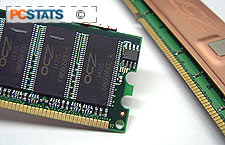 While OCZ do sell a great deal of memory, they not
actually manufacture the silicon wafers, or individual DRAM chips that eventually
make it onto OCZ-branded RAM.
While OCZ do sell a great deal of memory, they not
actually manufacture the silicon wafers, or individual DRAM chips that eventually
make it onto OCZ-branded RAM.
Rather, the
company does what many other 'fabless' manufacturers have done, and
select unmarked memory modules from a major DRAM manufacturer like Hynix,
Samsung and Winbond to name a few possible examples.
This is not
a negative point by any means, most enthusiast memory manufacturers like Corsair
and Mushkin are supplied with DRAMs by a third party as well.
The DRAM on
the EL PC4200 DRAM reads X4W56080D-4L, and it's literally brand new as
OCZ haven't even put the specs for the memory on their semiconductor stats
page. With a 4ns rating,
the memory should be capable of hitting 250 MHz, but it seems as though OCZ are dead set
on squeezing a wee bit more out of them...
Bandwidth vs. Latency
Overclocking Tests
We first tested the EL PC4200 memory in an Intel
based test system, plugging the memory into an Abit IC7 MAX3 motherboard specifically. I immediately changed the
memory timings from 2.5-4-4-7 to 2-2-2-5 and left the FSB at stock speeds. Unfortunately the system
refused to post.
Next, I adjusted the timings to run at 2-3-3-6, but this was good only
up to 210 MHz FSB. After a bit of tinkering, the only memory timings I could
get the DIMM's to work with at anything higher than 210 MHz, was their rated 2.5-4-4-7
at 2.8V settings. The OCZ EL PC4200 memory did work just fine with the 5:4
and 3:2 memory divider; those of you who run extremely high FSB's will want to take
note of that.
After going back to 2.5-4-4-7 (2.8V) it was
pretty smooth sailing; 250 MHz came and went easily, as did 266 MHz. In the
end the 512MB EL PC4200 memory modules maxed out at 271 MHz while
maintaining 2.5-4-4-7 timings at a voltage of 2.8V. They could actually reach
280 MHz FSB, but 3DMark would drop back to desktop every now and then so
things weren't stable. Setting DIMM voltage above 2.8V (I tested up to
3.4V) didn't help any, and actually decreased the speed the sticks ran at
substantially.
Paired with an AMD AthlonXP 3200+
processor the twin sticks of OCZ's EL PC4200 DDR memory were able to
run with CAS latency timings of 2-3-3-6. The maximum speed were were
able to reach on an Albatron KX18D motherboard with the 2-3-3-6 timings was
214 MHz FSB, at 2.8V. That is not the highest we have ever gone with a pair of
DDR, but considering the timings, it's not too bad either.
The OCZ EL PC4200 memory
did not prove to overclock very well under an
AMD Athlon64 3200+ environment, curiously. The modules ran with their SPD settings, but the max speed
the memory would overclock to was just 202 MHz. It should be pretty obvious then, that
the OCZ EL PC4200 dual channel DDR memory kit is best suited towards Intel
enthusiasts.
